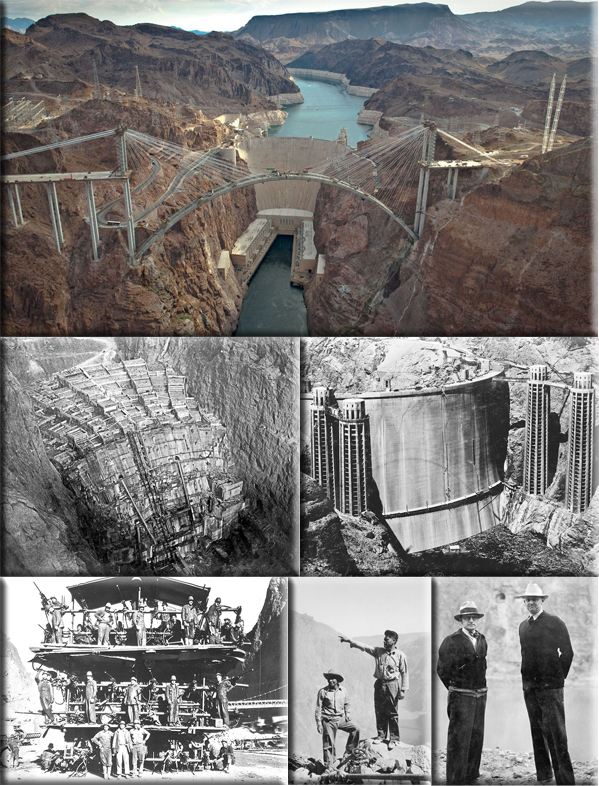
Hoover Dam begins transmitting electricity to Los Angeles on October 9, 1936
Hoover Dam: On this day in 1936, harnessing the power of the mighty Colorado River, Hoover Dam begins sending electricity over transmission lines spanning 266 miles of mountains and deserts to run the lights, radios, and stoves of Los Angeles.
Initially named Boulder Dam, work on the dam was begun under President Herbert Hoover's administration but completed as a public works project during the Roosevelt administration (which renamed it for Hoover). When it was finished in 1935, the towering concrete and steel plug was the tallest dam in the world and a powerful symbol of the new federal dedication to large-scale reclamation projects designed to water the arid West. In fact, the electricity generated deep in the bowels of Hoover Dam was only a secondary benefit. The central reason for the dam was the collection, preservation, and rational distribution of that most precious of all western commodities, water.
Under the guidance of the Federal Reclamation Bureau, Hoover Dam became one part of a much larger multipurpose water development project that tamed the wild Colorado River for the use of the growing number of western farmers, ranchers, and city dwellers. Water that had once flowed freely to the ocean now was impounded in the 115-mile-long Lake Mead. Massive aqueducts channeled millions of gallons of Colorado River water to California where it continues to this day to flow from Los Angeles faucets and irrigate vast stretches of fertile cropland.
With Hoover Dam, the federal government set out to demonstrate that the aridity of a region once called the Great American Desert need be no serious obstacle to its full settlement and development. However, as rapidly growing western cities like Los Angeles, Las Vegas, and Phoenix today face increasing difficulties in obtaining the water they need, it remains to be seen if the Great American Desert might still dictate its own limits to western growth.
History Channel / Wikipedia / Arizona Parks and Monuments
Wikipedia Image: Hoover Dam (Wallpaperweb.org)
• Construction of Hoover Dam (Bureau of Reclamation)
• Hoover Dam Jumbo Rig Workers on a “Jumbo Rig” - used for drilling Hoover Dam's tunnel (Bureau of Reclamation)
• Apache Indians employed as high-scalers on the construction of Hoover Dam - NARA - 293746 (U.S. National Archives)
• Frank Crowe, General Superintendent Frank Crowe (right) with Bureau of Reclamation engineer Walker Young in 1935 (Bureau of Reclamation photographer)
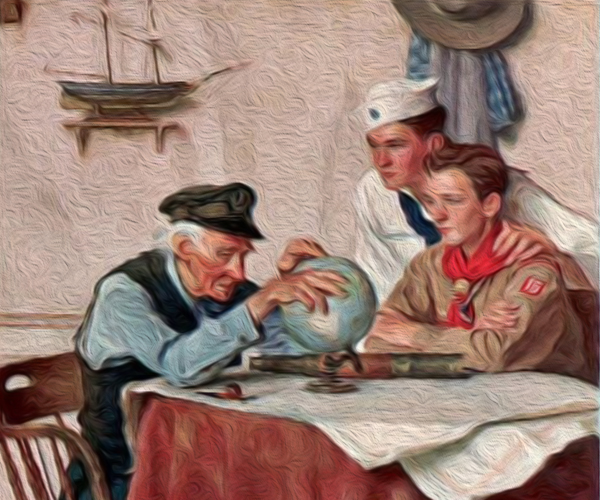
Understanding Military Terminology - estimative intelligence
(DOD) Estimative intelligence:
Intelligence that identifies, describes, and forecasts adversary capabilities and the implications for planning and executing military operations.Words of estimative probability Wikipedia
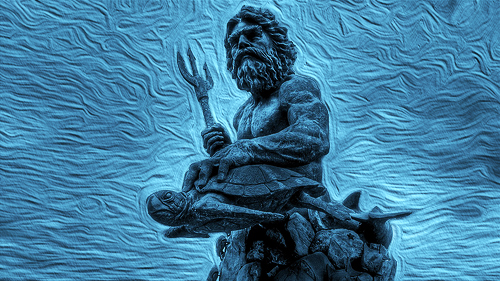
The Old Salt’s Corner
“Right of way”: A commonly held misconception concerning the rules of marine navigation is that by following specific rules, a vessel can gain certain rights of way over other vessels. No vessel ever has absolute “right of way” over other vessels. Rather, there can be a “give way” (burdened) vessel and a “stand on” (privileged) vessel, or there may be two give way vessels with no stand on vessel.
A stand on vessel does not have an absolute right of way over any give way vessel, for if there is a risk of collision, a stand on vessel may still be obliged under rules to give way so as to avoid it, if doing so will be effective and is practicable.
Two power-driven vessels approaching each other head to head, are both deemed to be “give way” and both are required to alter course so as to avoid colliding with the other. Neither vessel has “right of way”.Navigation Center USCG.gov

“I’m Just Sayin’”
I smile because I don’t know what the heck is going on.

“Thought for the Day”
“Maturity begins to grow when you can sense your concern for others outweighing your concern for yourself.”
~ John Macnaughton
“What I Have Learned”
Experience is something you don't get until just after you need it.
~ Steven Wright

Bizarre News (we couldn’t make up stuff this good – real news story)
A UK health inspector recently reported finding the body of a dead lion in a restaurant's freezer during an inspection. The frozen animal was lying next to the food to be served to customers. The restaurant owner insisted he wasn't planning on serving the lion to customers. Instead, he was going to feed the meat to his dogs. He had received the lion from a nearby zoo. Mirror UK
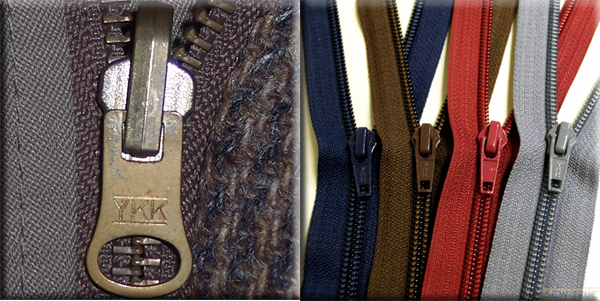
Mr. Answer Man Please Tell Us: Who invented the zipper and why do most Zippers have the letters YKK on them?
Whitcomb L. Judson invented the zipper and YKK is the Japanese company that makes them.
Whitcomb L. Judson was a lover of gadgets and machines and the idea for his “clasp locker” came from when a friend had a stiff back from trying to fasten his shoes. Judson's clasp locker was used mostly on mailbags, tobacco pouches and shoes. However, his design, like most first inventions needed to be fine-tuned.
A more practical version came on the scene in 1913 when a Swedish-born engineer, Gideon Sundback revised Judson's idea and made his with metal teeth instead of a hook and eye design. In 1917, Sundback patented his “separable fastener”.
The name changed again when the B. F. Goodrich Co. used it in rubber boots, galoshes, and called it the “zipper” because the boots could be fastened with one hand.
The 1940s brought about research in Europe of the coil zipper design. The first design was of interlocking brass coils. However, since they could be permanently bent out of shape, making the zipper stop functioning, it was rather bad for business and wasn't too practical. The new design was improved after the discovery of stronger, more flexible synthetics. Coil zippers eventually hit the market in the early 1960s.
In 1934, Yoshida Kogyo Kabushililaisha was founded. Sixty years later they changed their name to YKK Co. The privately owned firm, headquartered in Japan, now is made up of 80 companies at 206 facilities in 52 countries. YKK makes everything from the dyed fabric around the zipper to the brass used to make the actual device.
Image: Who invented the zipper and why do most Zippers have the letters YKK on them? (Bing Image Search - YKK Zipper)
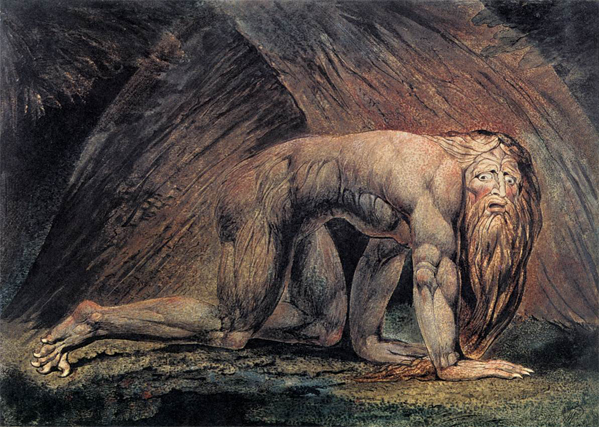
Where Did That Saying Come From?
“Escaped by the skin of your teeth:” This phrase comes from the Bible, from Job 19:20.
King James Version of the Bible states “My bone cleaveth to my skin and to my flesh, and I am escaped with the skin of my teeth.”.
Geneva Bible, the phrase is rendered as “I haue escaped with the skinne of my tethe.” Phrases.org.UK
Image: William Blake's Nebuchadnezzar (by William Blake, depicting the king during his bout of insanity) (Divine Living Library)

NAVSPEAK aka U.S. Navy Slang
IA: “Individual Augmentation/Augmentee”. Program use by the U.S. Navy to deploy sailors on an individual basis to the Middle East for 6-14 months in support of Operations IRAQI FREEDOM and ENDURING FREEDOM.
Personnel who complete IAs are (supposedly) given preferential treatment with regards to follow-on orders and promotion boards. IAs are often referred to as “Sand Sailors” or “being in the Narmy”. [Navy+Army=Narmy]
IFBM: Instant F**king Boatswains Mate. “A” school washout assigned to deck force.
Spunk: Cool Whip or anything like it.
Squid: Submariner. Like a squid, they also live under water and eat other squid/fish. Generally, any sailor (current or former) in the Navy.
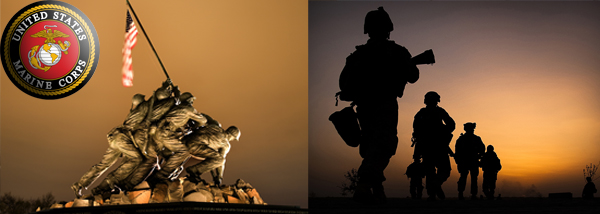
Just for you MARINE
Chow Hall: Place where meals are served, sometimes called a Mess. See Mess Deck.
Chuck: (Vietnam) A reference to white Marines by black Marines.
CID: Criminal Investigation Division. A unit of the Military Police charged with criminal investigations, polygraph examinations and other detective work. They are both commissioned and non-commissioned officers but wear civilian clothing and their rank is indicated as Investigator. They work closely with Naval Criminal Investigation Service (formerly NIS).
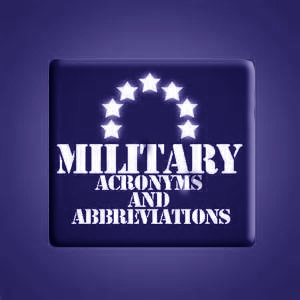
Navy Acronyms
BS - Battle Stations
The final test at Boot Camp that determines the passage to becoming a U.S. Navy Sailor. On board ship, a location and conditions to respond to when under attack or experiencing an emergency such as a fire.
BUD/S - Basic Underwater Demolition/SEAL
A SEAL training course that develops mental and physical stamina as well as leadership skills
BUPERS - Bureau of Navy Personnel
Organization served to provide administrative leadership, policy planning and general oversight of the Navy.
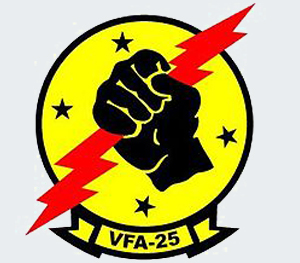
Naval Aviation Squadron Nicknames
VFA-25 - Strike Fighter Squadron 25: “Fist of the Fleet” NAS Lemoore, California

The Strange, Mysterious or Downright Weird
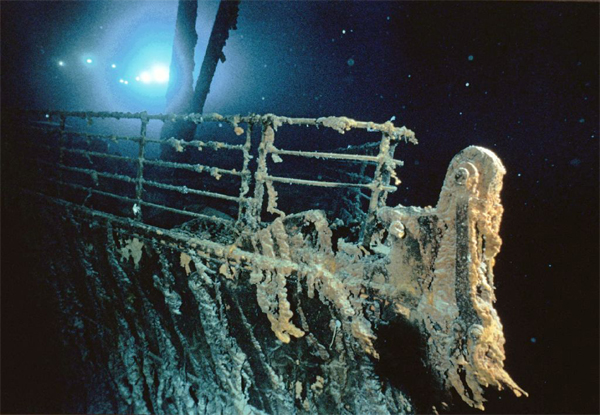
We all know the terrible story of The Titanic which sank into the icy ocean in April of 1912 killing 1522 people. What if I told you that disaster could have been avoided?
A second officer by the name of David Blair was removed from the ship’s roster right before the ship’s departure from Southhampton. In all the haste to replace him, Blair forgot to pass the key to the crow’s nest locker which contained the binoculars vital for the lookouts.
After the disaster a U.S. inquiry was held and Fred Fleet, a surviving lookout testified that they did not have binoculars on the voyage. Had they done so, he said, they could have seen the iceberg earlier. When asked by the chairman of the inquiry “How much earlier?” Fleet replied, “Well, enough to get out of the way.” Someone asked why didn’t anyone on the ship bother to breakdown the locker door and get the darn binoculars? “I have not an answer for that, and I myself wondered why myself.”
Blair’s descendants kept the key that could’ve prevented this awful disaster as a memento for a long time. They finally put it up for auction in 2007 and it sold for $148,000. History Confidential
Image: Titanic wreck pictures (Explore Titanic)
OH WHAT A YEAR - 1934
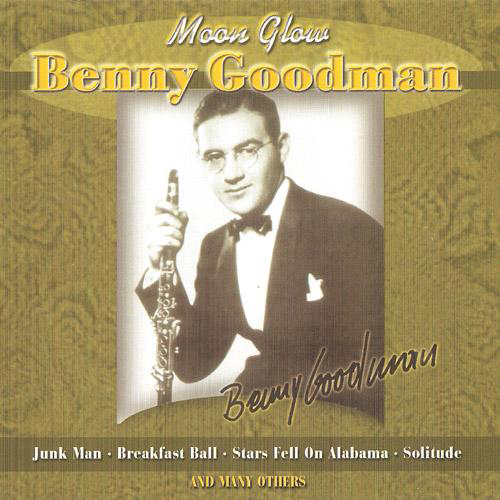
1. Moon Glow - Benny Goodman
2. Continental (you Kiss While You're Dancing) - Leo Reisman
3. Tumbling Tumbleweeds - The Sons of the Pioneers
4. Smoke Gets in Your Eyes - Paul Whiteman
5. Cocktails For Two - Duke Ellington
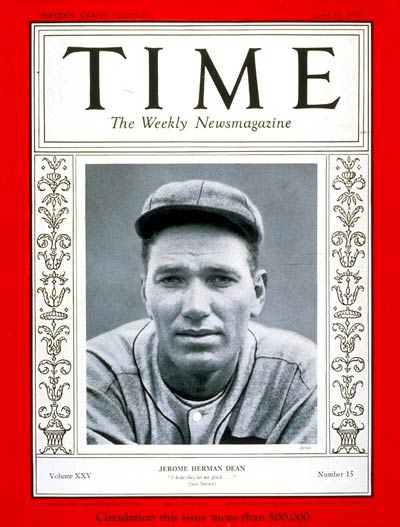
● World Series Champions: The St. Louis Cardinals defeat the Detroit Tigers 4 games to 3
● Major League Baseball All-Star Game: left–handed Pitcher Carl Hubbell sets a record by striking out Babe Ruth, Lou Gehrig, Jimmie Foxx, Al Simmons, Joe Cronin consecutivley.
● NFL Champions: New York Giants defeat the Chicago Bears 30–13
● Stanley Cup Champs: Chicago Black Hawks defeat the Detroit Red Wings 3 games to 1
● U.S. Open Golf: Olin Dutra
● U.S. Open Tennis (Men/Ladies): Fred Perry / Helen H. Jacobs
● Wimbledon (Men/Women) (Men/Ladies): Fred Perry / Dorothy Round
● NCAA Football Champions: Minnesots Golden Gophers shared with Alabama Crimson Tide
● Kentucky Derby: Cavalcade
Image: Dizzy Deane - Time magazine cover 1935 World Series: Brothers Dizzy Dean and Paul Dean each won two games for the “Gas House Gang” Cardinals.
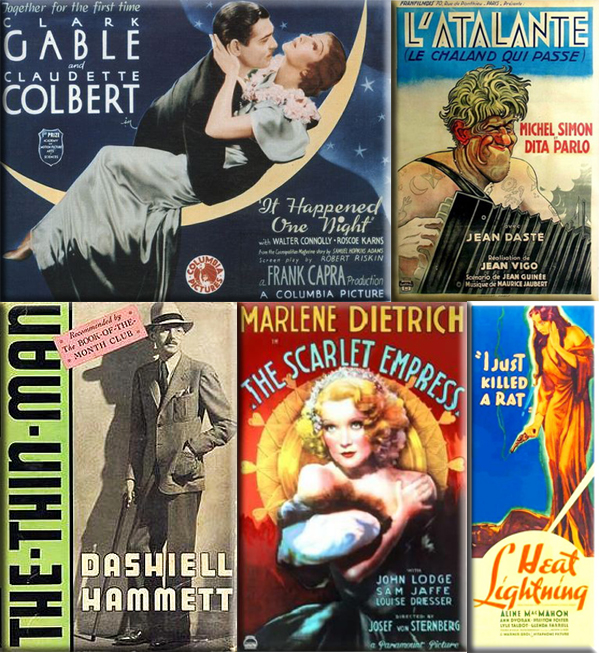
1. It Happened One Night
2. L'Atalante
3. The Thin Man
4. The Scarlet Empress
5. Heat Lightning
Image: Most Popular Movies: 1934: It Happened One Night, L'Atalante, The Thin Man, The Scarlet Empress and Heat Lightning
Most Popular Christmas gifts 1934
● Sorry! Board Game
● Radio Flyer

● “Take my wife, please”
~ Henny Youngman
● “When you care enough to send the very best”
~ Hallmark cards
Image: Henny Youngman “Geraldine” on The Ed Sullivan Show 

Trivia
● During the football season of 1905, at least 19 players died in college and high school contests.
● Of all the major brewing nations, England remains the only one in which ale is the primary beer consumed. This is in contrast to lager, which is the world's overall dominant beer style.
● “Baby-cut” carrots aren’t baby carrots. They’re actually full-sized ones peeled and polished down to size. And there’s nothing small about their current popularity: about 25 percent of California’s fresh carrot crop is turned into “babies”.
A Test for People Who Know Everything
What are the names of the four colored ghosts featured on the PacMan video arcade game?
● Answer for People Who Do Not Know Everything, or Want to Verify Their AnswerWikipedia
Answer to Last Week's Test
What is the name of the little guy with the monocle who appears at various places on the board game Monopoly?
Answer: Rich Uncle Pennybags.
Joke of the Day
As Mr. Smith was on his death bed, he attempted to formulate a plan that would allow him to take at least some of his considerable wealth with him. He called for the three men he trusted most--his lawyer, his doctor, and his clergyman. He told them, “I'm going to give you each $30,000 in cash before I die. At my funeral, I want you to place the money in my coffin so that I can try to take it with me.”
All three agreed to do this and were given the money. At the funeral, each approached the coffin in turn and placed an envelope inside.
While riding in the limousine back from the cemetery, the clergyman said, “I have to confess something to you fellows. Brother Smith was a good churchman all his life, and I know he would have wanted me to do this. The church needed a new baptistery very badly, and I took $10,000 of the money he gave me and bought one. I only put $20,000 in the coffin.”
The physician then said, “Well, since we're confiding in one another, I might as well tell you that I didn't put the full $30,000 in the coffin either. Smith had a disease that could have been diagnosed sooner if I had this very new machine, but the machine cost $20,000 and I couldn't afford it then. I used $20,000 of the money to buy the machine so that I might be able to save another patient. I know that Smith would have wanted me to do that.”
The lawyer then said, “I'm ashamed of both of you. When I put my envelope into that coffin, it held my personal check for the full $30,000.”




















